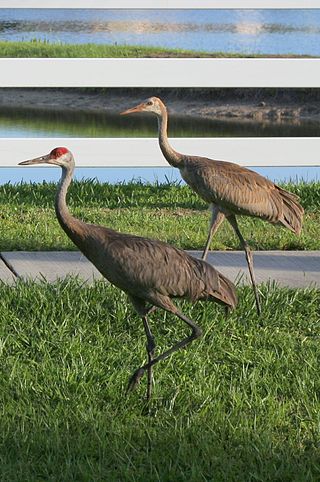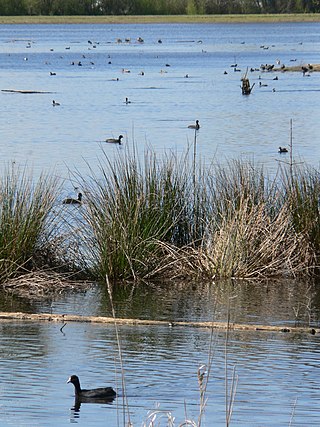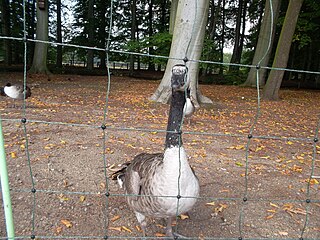
The nene, also known as the nēnē or the Hawaiian goose, is a species of bird endemic to the Hawaiian Islands. The nene is exclusively found in the wild on the islands of Oahu, Maui, Kauaʻi, Molokai, and Hawaiʻi. In 1957, it was designated as the official state bird of the state of Hawaiʻi.

The greylag goose or graylag goose is a species of large goose in the waterfowl family Anatidae and the type species of the genus Anser. It has mottled and barred grey and white plumage and an orange beak and pink legs. A large bird, it measures between 74 and 91 centimetres in length, with an average weight of 3.3 kilograms. Its distribution is widespread, with birds from the north of its range in Europe and Asia often migrating southwards to spend the winter in warmer places, although many populations are resident, even in the north. It is the ancestor of most breeds of domestic goose, having been domesticated at least as early as 1360 BCE. The genus name and specific epithet are from anser, the Latin for "goose".

The snow goose is a species of goose native to North America. Both white and dark morphs exist, the latter often known as blue goose. Its name derives from the typically white plumage. The species was previously placed in the genus Chen, but is now typically included in the "gray goose" genus Anser.

The barnacle goose is a species of goose that belongs to the genus Branta of black geese, which contains species with largely black plumage, distinguishing them from the grey Anser species. Despite its superficial similarity to the brant goose, genetic analysis has shown it is an eastern derivative of the cackling goose lineage.

The red-breasted goose is a brightly marked species of goose in the genus Branta from Eurasia. It is currently classified as vulnerable by the IUCN.

The Canada goose is a large species of goose with a black head and neck, white cheeks, white under its chin, and a brown body. It is native to the arctic and temperate regions of North America, and it is occasionally found during migration across the Atlantic in northern Europe. It has been introduced to France, the United Kingdom, Ireland, Finland, Sweden, Denmark, New Zealand, Japan, Chile, Argentina, and the Falkland Islands. Like most geese, the Canada goose is primarily herbivorous and normally migratory; often found on or close to fresh water, the Canada goose is also common in brackish marshes, estuaries, and lagoons.

The sandhill crane is a species of large crane of North America and extreme northeastern Siberia. The common name of this bird refers to their habitat such as the Platte River, on the edge of Nebraska's Sandhills on the American Great Plains. Sandhill cranes are known to frequent the edges of bodies of water. The central Platte River valley in Nebraska is the most important stopover area for the nominotypical subspecies, the great sandhill crane, with up to 450,000 of these birds migrating through annually.

The spur-winged goose is a large, Sub-Saharan African waterbird in the family Anatidae, which includes geese and shelducks. However, P. gambensis developed unique environmental adaptations, which resulted in the evolution of several anatomical features that are not shared with other anatids; thus, the species has been classified one step further into its own subfamily, the Plectropterinae.

The cackling goose is a species of goose found in North America and East Asia.

The brant or brent goose is a small goose of the genus Branta. There are three subspecies, all of which winter along temperate-zone sea-coasts and breed on the high-Arctic tundra.
The nēnē-nui or wood-walking goose is an extinct species of goose that once inhabited Maui and possibly Kauaʻi, Oʻahu and perhaps Molokaʻi in the Hawaiian Islands. It is known from a large number of subfossil bones found in Holocene cave sediments.

Ankeny National Wildlife Refuge is located in the fertile Willamette Valley of northwestern Oregon, 12 miles (19 km) south of Salem. The valley was once a rich mix of wildlife habitats. Valley wetlands were once extensive, with meandering stream channels and vast seasonal marshes. Today, the valley is a mix of farmland and growing cities, with few areas remaining for wildlife.

Baskett Slough National Wildlife Refuge is in northwestern Oregon, 10 miles (16 km) west of Salem in Polk County. The Refuge consists of 1,173 acres (4.75 km2) of cropland, which provide forage for wintering geese, 300 acres (1.2 km2) of forests, 550 acres (2.2 km2) of grasslands, and 500 acres (2.0 km2) of shallow water seasonal wetlands and 35 acres (0.14 km2) of permanent open water. In 1965, Baskett Slough National Wildlife Refuge was created to help ensure some of the original habitat remained for species preservation. The refuge is managed by the U.S. Fish and Wildlife Service, an agency of the U.S. Department of the Interior.

The Aleutian cackling goose is a small subspecies of the cackling goose averaging 1.7 to 2.1 kg in weight. It was one of 122 species of animals, birds, and fishes first documented for science by the Lewis and Clark Expedition.

The Canada goose was introduced to New Zealand as a game bird in 1905. They became problematic because of damage they cause to pastures and crops.
The dusky Canada goose is a subspecies of the Canada goose. They are the darkest variant, similar to the Pacific cackling goose. Tagged dusky geese have red bands with white letters on them attached to their neck. They represent one of the smallest populations of Canada goose in the Pacific Northwest. Due to the species' minimal population and exclusive breeding grounds, the dusky Canada goose is a species of interest to the Pacific Flyway Council and the U.S. Forest Service. The Cordova Ranger District, on the Chugach National Forest, has been working since 1984 to implement a monitoring and restoration program for the geese.

The giant Canada goose is the largest subspecies of Canada goose, on average weighing in at 5 kg. It is found in central North America. These geese were at one point considered extinct, but were later rediscovered. The giant Canada goose was once kept and bred in captivity for use as hunting decoys and for food.

The small cackling goose, also known as the Ridgway's goose, is the smallest subspecies of cackling goose and the smallest variant of white-cheeked goose.
The Atlantic Canada goose is the nominate subspecies of Canada goose, residing in much of the east coast of North America. It has also been introduced to much of Northern Europe and Western Europe. They are often viewed as pests, especially in places they have been introduced to. The Canada goose was first described by Carl Linnaeus in 1758.
The Vancouver Canada goose is a subspecies of Canada goose, residing in western British Columbia and southern Alaska.















